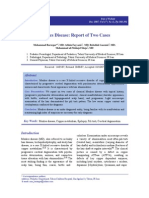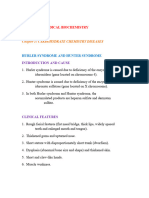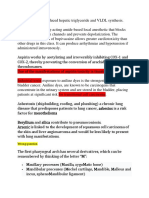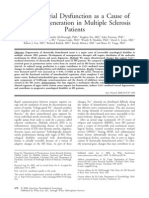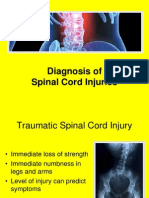Menkes Kinky Hair Disease (Menkes Syndrome) - A Case Report
Menkes Kinky Hair Disease (Menkes Syndrome) - A Case Report
Uploaded by
Tannov SiregarCopyright:
Available Formats
Menkes Kinky Hair Disease (Menkes Syndrome) - A Case Report
Menkes Kinky Hair Disease (Menkes Syndrome) - A Case Report
Uploaded by
Tannov SiregarOriginal Title
Copyright
Available Formats
Share this document
Did you find this document useful?
Is this content inappropriate?
Copyright:
Available Formats
Menkes Kinky Hair Disease (Menkes Syndrome) - A Case Report
Menkes Kinky Hair Disease (Menkes Syndrome) - A Case Report
Uploaded by
Tannov SiregarCopyright:
Available Formats
Menkes kinky hair disease
Case report
Menkes kinky hair disease (Menkes syndrome). A case report
P. Fister, J. Raku{, Z. Rener Primec and B. Gnidovec Strai{ar
SUMMARY
Menkes disease (MD) is a rare genetic neurodegenerative disorder. It is caused by a mutation in the ATP7A gene, which codes for the copper-transporting ATPase in the cell organelles. Dysfunction of many copper-dependent enzymes results in low concentrations of copper in some tissues and accumulation of copper in others. We report on a boy that at the age of 2 months presented with encephalopathy with epileptic seizures and later had a progressive developmental disorder. Despite treatment with various antiepileptic drugs, some seizures still persisted. Our diagnosis was made on the basis of clinical and laboratory findings. We also plan to confirm the diagnosis genetically. To the best of our knowledge, this is the first reported case of MD in Slovenia. Treatment of MD is usually not successful, especially in sporadic cases, because it usually begins too late. Early neonatal treatment may be successful in half of the cases.
Introduction
Neurodegenerative disorders encompass a number of heterogeneous diseases that develop as a consequence of specific genetic and biochemical defects or chronic viral infections, as well as a group of disorders of yet unknown etiology. Progressive deterioration of neurological functions is a characteristic of neurodegenerative disorders. We distinguish between diseases that primarily affect the white or gray matter of the brain according to the age at onset of the disease, the rate of progression, and principal neurological deficiencies (1, 2). Menkes disease (MD) belongs to a group of diseases that mainly affect the gray matter of the brain. The predominant clinical findings are twisted, kinky, short, sparse, coarse, whitish, silver, or gray hair, eyebrows, and eyelashes. Children with MD have sagging cheeks and ears, a depressed nasal bridge, a high arched palate, and delayed dentition (3). Progressive cerebral degeneration is manifested in loss of developmental stages, seizures, truncal hypotonia with limb hypertonia and temperature instability (46). Ocular manifestations include ptosis, visual inattention, optic disc pallor, decreased papillary responses to light, hypoplasia, and hypopigmentation of the iris (7). Because of the
K E Y WORDS
neurodege nerative disorder, Menkes disease, child
126
Acta Dermatoven APA Vol 15, 2006, No 3
Case report
Menkes kinky hair disease
connective tissue fragility, hernias, bladder diverticuli, loose skin, and hypermobile joints occur (8, 9). Vascular fragility can result in arterial ruptures, thromboses, and infarcts (10). Children can be born with congenital fractures, and later in life the bones are deformed and osteoporotic, with metaphyseal spurs and widening of the posterior portion of vertebral bodies (11). Patients may have bleeding diathesis, including urinary bladder, abdominal, and intracranial hemorrhages (12, 13). MD is one of the four known disorders of copper metabolism. Together with occipital horn syndrome, it results from copper deficiency secondary to disturbances in copper transport. Wilsons disease and Indian childhood cirrhosis, on the other hand, result from the toxic effects of copper accumulation in the liver (14). In healthy children, concentrations of plasma copper and ceruloplasmin tend to be low during the first 3 weeks of life, may decrease even after the 6th week of life, and can sometimes be low even up to 6 months of age. In any case, plasma copper below 25% of normal range and low plasma ceruloplasmin concentrations can be diagnostic of MD after the 3rd week of life (15).
Case report
L. M. was born in March 2005 to healthy unrelated parents at 35 weeks gestational age; birth weight 2,100 g (10th50th percentile), birth length 43 cm (5th percentile), head circumference 37.5 cm (1.5 cm > 95th percentile), and Apgar score 8/9. Due to respiratory distress, he needed an increased percentage of oxygen in inhaled air for 5 days and was treated with antibiotics because of suspected infection. He was discharged from the hospital on his 13th day of life. The infant was well until the age of 2.5 months, when the parents noticed eyelid twitching, gazing directly upwards, transitory arm stiffness, and body atony. He was admitted to the hospital, where the convulsions discontinued after diazepam. He was afebrile with no signs of infection, and the results of laboratory tests (blood, urine, cerebrospinal fluid (CSF)), microbiological cultures (blood, CSF, stool), and imaging studies (chest X-ray, head and abdomen ultrasound) were unremarkable. The ophthalmologist noticed poor fixation. The first electroencephalogram (EEG) was abnormal, but the second EEG was appropriate for his age. The infant was discharged from the hospital without treatment. At the age of 3 months, similar seizures recurred while the infant was afebrile. Further tests (urine organic acids, serum amino acids, blood lactate and pyruvate levels, blood gas analysis) were carried out to screen for possible metabolic disorders, but all results were within normal limits. The EEG was abnormal with pseudoperiodic complexes of biphasic sharp waves and slow waves over the left hemisphere, with spikes over
Acta Dermatoven APA Vol 15, 2006, No 3
the left temporo-occipital lobe. Magnetic resonance imaging (MRI) showed cortical atrophy, and there was also an intensified signal in the basal ganglia, cerebellum, and brainstem (Figure 1). After the emergency, treatment with diazepam phenobarbital was introduced. Neurologically, axial hypotonia and loss of head control were noticed. Two weeks later he had an episode of tonicclonic convulsions. Neurological assessment disclosed hypotonia, poor spontaneous movements, and only occasional eye-to-eye contact. The EEG was abnormal with intermittent dysrhythmic activity over both hemispheres. Magnetic resonance angiography (MRA) showed extreme tortuosity of the intracranial vessels (Figure 2). Due to repeated convulsions while on phenobarbital treatment, carbamazepine was added. At the age of 4.5 months he had frequent convulsions despite the introduction of a third antiepileptic drug (vigabatrin, in addition to phenobarbital and carbamazepine); his distress continued and he was readmitted to our department. In addition to the above signs we noticed a high arched palate and a right-sided inguinal hernia. His hair was sparse, and the typical clinical appearance was not pronounced, especially not in the very early course of the disease (Figure 3). Developmental delay was prominent with truncal hypotonia and limb hypertonia. Specific MRI and MRA changes, together with distinct clinical signs, caused us to suspect a neurodegenerative disorder, and MD was then confirmed by low levels of plasma copper and ceruloplasmin. We are attempting to confirm the diagnosis by molecular genetic testing. Modification of antiepileptic therapy reduced seizures by about 50%, but erratic myoclonus and some clonic seizures persisted.
Discussion
MD is a degenerative, X-linked, recessive, multisystem disorder. So far more than 160 different mutations of the ATP7A gene on the long arm of the X chromosome close to the centromere have been described (15 17). ATP7A gene codes for a copper-binding enzyme P-type ATPase that is essential for intracellular copper transport and metabolism. The disease is also called a disorder of copper maldistribution. The reduction, complete absence, or functional impairment of this enzyme results in the accumulation of copper in the cytosol of many cells. The copper concentration is high in the gut, kidney, spleen, pancreas, muscles, and placenta, with the exception of the liver and brain, where the concentration of copper is reduced. The plasma concentration of copper is also low (15, 18). The low concentrations (25%) of normal ATP-ase in blood are sufficient to permit the development of
127
Menkes kinky hair disease
Case report
Figure 1. Magnetic resonance imaging of the brain of a patient with Menkes disease. There is high signal intensity in the basal ganglia and cerebellum (white arrows). Wide subarachnoid space frontally and around the cerebellum with ventriculomegaly represent diffuse atrophy of the brain and cerebellum.
nantly have connective tissue and bone signs. They have hyperelastic skin, hyperextensible joints, hernias, and urinary bladder diverticuli. The disease is named after skeletal abnormalities: the occipital exostoses (horns), which are wedge-shaped calcifications at the occipital insertion of the trapezius and sternocleidomastoid muscles. Copper is an essential trace element needed for the activity of many enzymes. The lack of copper leads to decreased activity of cytochrome C oxidase in the respiratory chain, which accounts for many neurological symptoms. The enzyme lysyl oxidase connects the collagen and elastin fibers, and reduced activity leads to fragility of connective tissue and blood vessels. The superoxide dismutase is an antioxidant enzyme in Purkinje cells. Its inactivity in MD results in profound loss of Purkinje cells. Tyrosinase is essential for melanin synthesis and its deficiency causes hair and skin hypopigmentation. The structural hair changes result from a defect in a copper-enzyme dependent cross-
the milder phenotype, also called occipital horn syndrome, Ehlers-Danlos type IX, or X-linked cutis laxa (16, 1820). Patients with the mild phenotype predomi-
Figure 3. Abnormal, depigmented, short, sparse, and twisted hair in a patient with Menkes disease.
linkage of disulfide bonds in keratin. Ceruloplasmin is a plasma copper-transporting protein that is low in patients with MD. The reduced activity of ascorbate oxidase induces skeletal changes, as seen in scurvy. Deficiency of dopamine -hydroxyilase is evident in abnormal plasma and CSF concentrations of catecholamines. Peptidyl-glyicine -amidating monooxygenase is required for the synthesis of neuroendocrine hormones (corticotropin-releasing hormone, thyrotropin-releasing hormone, calcitonin and vasopressin) (46, 15). MD almost exclusively affects males, but there are some reports of affected females with a genetic disorder of the X chromosome (translocations among autosomes and the X chromosome, sex chromosome aneu-
Figure 2. Magnetic resonance angiography of intracranial vessels shows the corkscrew appearance of elongated and tortuous cerebral vessels.
128
Acta Dermatoven APA Vol 15, 2006, No 3
Case report
Menkes kinky hair disease
ploidy, or unfavorable lyonization) (4, 21, 22). Incidence is estimated at a range of 1 per 35,000300,000 live births; in one third of patients the disease is a consequence of de novo mutation (6, 15). There is no race predilection. The disease becomes evident at the age of 2 to 3 months; patients die by the time they are 3 to 4 years old usually because of pneumonia, although some patients with MD may die suddenly (4, 6, 23). Diagnosis is suspected on the basis of the typical facial expression, characteristic appearance of the hair, and seizures. Some authors suggest a careful hair and eyebrow clinical exam in patients with delayed developmental milestones and early epilepsy without clear etiology (24). Low plasma copper and ceruloplasmin concentrations confirm the diagnosis. Because low plasma concentrations of copper and ceruloplasmin can be found in healthy children within the first weeks or even months of life, low concentrations are more meaningful after this time (15, 25). The concentrations of plasma and CSF catecholamines tend to be abnormal at all ages (46, 25). In the past, the final diagnosis was made by cultured skin fibroblasts and lymphoblasts, which showed impaired metabolism of copper. Today this method is being replaced by molecular genetic testing, available in certain laboratories, to confirm the diagnosis for carrier testing or for prenatal diagnosis (25). After birth we can detect increased placental copper levels (46). Abnormalities can be detected by some non-specific tests such as EEG, visual-evoked potentials, electroretinogram, and brainstem evoked acoustic potentials (46). Imaging studies (CT in MRI) reveal white matter demyelinization, tortuous blood vessels, atrophy, and subdural hematomas. Angiography and MRA display elongated and tortuous vessels (26, 27).
Differential diagnosis includes Leigh disease (subacute necrotizing encephalomyelopathy), phenylketonuria, and certain diseases with specific hair findings (46). The low concentrations of copper and ceruloplasmin are, however, typical only of MD. Oral treatment with copper salts does not change the serum copper and ceruloplasmin concentrations and there is no clinical improvement (46, 15). Parenteral copper chloride and copper L-histidine are currently under investigation. Some reports suggest that if parenteral treatment starts early in neonatal life, up to the 2nd month of life, it may be successful in up to 50% of cases. The clinical response to parenteral treatment is more evidently detected in neurological improvement than in connective tissue defects (28). Metaphyseal widening and spurring and periosteal thickening regress. Concentrations of serum catecholamines normalize (46, 28, 29). If treatment is started after the critical time of 2 months, it is not of much help to the patient (28, 29). There is a case report (4) of a boy with classic MD that was diagnosed at birth and was treated with parenteral copper from the 8th day of life up to the 4th year. He began walking at 14 months and normal neurological development followed. In 2002 he was 8 years old and was attending elementary school.
Conclusion
MD can be diagnosed on the basis of clinical signs and laboratory findings, and genetically confirmed in certain laboratories. Treatment is usually not successful, especially in sporadic cases, because it usually starts too late. Only early treatment in the neonatal age is helpful in half of the cases.
REFERENCES
1. Johnston MV. Neurodegenerative disorders of childhood. In: Behrman RE, et al., editors. Nelson textbook of pediatrics, 17th ed. Philadelphia: Saunders; 2004. p. 202935. 2. Neubauer D. Repetitorij otro{ke nevrologije. Ljubljana: Medicinski razgledi; 2004: 122. 3. Brownstein JN, Primosch RE. Oral manifestations of Menkes kinky hair syndrome. J Clin Pediatr Dent 2001; 25: 31721. 4. Kaler SG. Menkes kinky hair disease. Available from: http://www.emedicine.com/ped/topic1417.htm 5. Imaeda S. Menkes kinky hair disease. Available from: http://www.emedicine.com/derm/ topic715.htm 6. Chang CH. Menkes disease. Available from: http://www.emedicine.com/neuro/topic569.htm 7. Gasch AT, Caruso RC, Kaler SG, Kaiser-Kupfer M. Menkes syndrome: ophthalmic findings. Ophthalmology 2002; 109: 147783. 8. Mandelstam SA, Fisher R. Menkes disease: a rare cause of bilateral inguinal hernias. Australas Radiol 2005; 49: 1925. 9. Oshio T, Hino M, Kirino A, Matsumura C, Fukuda K. Urologic abnormalities in Menkes kinky hair disease: report of three cases. J Pediatr Surg 1997; 32: 7824. 10. Hsich GE, Robertson RL, Irons M, Soul M, du Plessis AJ. Cerebral infarction in Menkes disease. Pediatr Neurol 2000; 23: 4258.
Acta Dermatoven APA Vol 15, 2006, No 3
129
Menkes kinky hair disease
Case report
11. Ubhi T, Reece A, Craig A. Congenital fracture as a presentation of Menkes disease. Dev Med Child Neurol 2000; 42: 3478. 12. Jankov RP, Boerkoel CF, Hellmann J, et al. Lethal neonatal Menkes disease with severe vasculopathy and fractures. Acta Paediatr 1998; 87: 1297300. 13. Nassogne MC, Sharrard M, Hertz-Pannier L, et al. Massive subdural haematomas in Menkes disease mimicking shaken baby syndrome. Childs Nerv Syst 2002; 18: 72931 14. Petrukhin K, Gilliam TC. Genetic disorders of copper metabolism. Curr Opin Pediatr 1994; 6: 698701. 15. Itin P, Happle R, Schaub N, Schiller P, Izakovic J, Fistarol SK. Hereditary metabolic disorders. In Schachner LA, et al., editors. Pediatric Dermatology, 3rd ed. Edinburgh, London, New York, Oxford, Philadelphia, St. Louis, Sydney, Toronto: Mosby; 2003. p. 35064. 16. Moller LB, Tumer Z, Lund C, et al. Similar splice-site mutations of the ATP7A gene lead to different phenotypes: classical Menkes disease or occipital horn syndrome. Am J Hum Genet 2000; 66: 121120. 17. Ogawa A, Yamamoto S, Takayanagi M, Kogo T, Kanazawa M, Kohno Y. Identification of three novel mutations in the MNK gene in three unrelated Japanese patients with classical Menkes disease. J Hum Genet 1999; 44: 2069. 18. Gu YH, Kodama H, Murata Y, et al. ATP7A gene mutations in 16 patients with Menkes disease and a patient with occipital horn syndrome. Am J Med Genet 2001; 99: 21722. 19. Borm B, Moller LB, Hausser I, et al. Variable clinical expression of an identical mutation in the ATP7A gene for Menkes disease/occipital horn syndrome in three affected males in a single family. J Pediatr 2004; 145: 11921. 20. Seidel J, Moller LB, Mentzel HJ, et al. Disturbed copper transport in humans. Part 1: mutations of the ATP7A gene lead to Menkes disease and occipital horn syndrome. Cell Mol Biol (Noisy-le-grand) 2001; 47: 1418. 21. Abusaad I, Mohammed SN, Ogilvie CM, Ritchie J, Pohl KR, Docherty Z. Clinical expression of Menkes disease in a girl with X;13 translocation. Am J Med Genet 1999; 87: 3549. 22. Sugio Y, Sugio Y, Kuwano A, et al. Translocation t(X;21)(q13.3; p11.1) in a girl with Menkes disease. Am J Med Genet 1998; 79: 1914. 23. Sfaello I, Castelnau P, Blanc N, Ogier H, Evrard P, Arzimanoglou A. Infantile spasms and Menkes disease. Epileptic Disord 2000; 2: 22730. 24. Venta-Sobero JA, Porras-Kattz E, Gutierrez-Moctezuma J. West syndrome as an epileptic presentation in Menkes disease. Two cases report. Rev Neurol 2004; 39: 1336. 25. Kaler SG. ATP7A-related copper transport disorders. Available from: ttp://www.genetests.org/servlet/ access 26. Husain AM, Smergel E, Legido A, et al. Comparison of MRI and MRA findings in children with a variety of neurologic conditions. Pediatr Neurol 2000; 23: 30711. 27. Kim OH, Suh JH. Intracranial and extracranial MR angiography in Menkes disease. Pediatr Radiol 1997; 27: 7824. 28. George DH, Casey RE. Menkes disease after copper histidine replacement therapy: case report. Pediatr Dev Pathol 2001; 4: 2818. 29. Munakata M, Sakamoto O, Kitamura T, et al. The effects of copper-histidine therapy on brain metabolism in a patient with Menkes disease: a proton magnetic resonance spectroscopic study. Brain Dev 2005; 27: 297300.
A U T H O R S ' A D D R E S S E S
Petja Fister, MD, University Childrens Hospital, University Medical Centre Ljubljana, Vrazov trg 1, 1525 Ljubljana, corresponding author. E-mail: petja_fister@yahoo.com Jona Raku{, MD, Clinic for Infectious Diseases, University Medical Centre Ljubljana, Japljeva ulica 2, 1000 Ljubljana Zvonka Rener Primec, MD, PhD, University Childrens Hospital, University Medical Centre Ljubljana, Vrazov trg 1, 1525 Ljubljana Barbara Gnidovec Strai{ar, MD, same address
Acta Dermatoven APA Vol 15, 2006, No 3
130
You might also like
- Neurology Multiple Choice Questions With Explanations: Volume IFrom EverandNeurology Multiple Choice Questions With Explanations: Volume IRating: 4 out of 5 stars4/5 (8)
- Genodermatosis MCQsDocument152 pagesGenodermatosis MCQsDr.Tawheed88% (8)
- Amyotrophic Lateral SclerosisDocument58 pagesAmyotrophic Lateral SclerosisAathi PathmanathanNo ratings yet
- Epilepsia EpicongressDocument245 pagesEpilepsia EpicongressВасилий КоптеловNo ratings yet
- Daily Equipment Cleaning RecordsDocument3 pagesDaily Equipment Cleaning RecordsmathanbhuNo ratings yet
- Administration of PICU Child Health NursingDocument37 pagesAdministration of PICU Child Health NursingJimcy100% (6)
- Use of LEGO As A Therapeutic Medium For Improving Social CompetenceDocument15 pagesUse of LEGO As A Therapeutic Medium For Improving Social CompetencejhebetaNo ratings yet
- Menkes Disease: Report of Two CasesDocument5 pagesMenkes Disease: Report of Two CasesrickyferdianNo ratings yet
- Neurodegener RalucaDocument88 pagesNeurodegener RalucaAlexandra AnaellyNo ratings yet
- Menkes Disease As A Differential Diagnosis of Child AbuseDocument3 pagesMenkes Disease As A Differential Diagnosis of Child AbuserickyferdianNo ratings yet
- Chenoy Gen BioDocument6 pagesChenoy Gen Bioraysa sepriaNo ratings yet
- 4 Epilepsy in A PatientDocument4 pages4 Epilepsy in A Patientarturschander3614No ratings yet
- ALL Diseases 2Document359 pagesALL Diseases 2biggyNo ratings yet
- Amyotrophic Lateral SclerosisDocument9 pagesAmyotrophic Lateral SclerosisCaroline ItnerNo ratings yet
- Rare Disease DatabaseDocument8 pagesRare Disease DatabaseBlueash BehNo ratings yet
- Alport FRenPro630Document0 pagesAlport FRenPro630SulastriNo ratings yet
- Nascimento Et Al. - 2012 - Adrenoleukodystrophy A Forgotten Diagnosis in Children With Primary Addison' S DiseaseDocument5 pagesNascimento Et Al. - 2012 - Adrenoleukodystrophy A Forgotten Diagnosis in Children With Primary Addison' S DiseaseflashjetNo ratings yet
- Hypocalcemia - Diagnosis and Treatment - Endotext - NCBI BookshelfDocument31 pagesHypocalcemia - Diagnosis and Treatment - Endotext - NCBI Bookshelfgalnaresdaniela7No ratings yet
- Childhood Leukodystrophies: A Clinical Perspective: ReviewDocument12 pagesChildhood Leukodystrophies: A Clinical Perspective: ReviewAnonymous fg5XXFOSj4No ratings yet
- Mitochondrial Encephalomyopathies (MEM)Document66 pagesMitochondrial Encephalomyopathies (MEM)Fatma KaledNo ratings yet
- Embryology, Central Nervous System, Malformations - StatPearls - NCBI BookshelfDocument7 pagesEmbryology, Central Nervous System, Malformations - StatPearls - NCBI Bookshelfleandro.silvaNo ratings yet
- Angelman Syndrome Phenotype Associated With Mutations in Mecp2, A Gene Encoding A Methyl CPG Binding ProteinDocument6 pagesAngelman Syndrome Phenotype Associated With Mutations in Mecp2, A Gene Encoding A Methyl CPG Binding ProteinAkmal NugrahaNo ratings yet
- Leukodystrophies and MucopolysacridosisDocument78 pagesLeukodystrophies and MucopolysacridosisMobin Ur Rehman KhanNo ratings yet
- LITERATURE REVIEW Alzheimer Disease - Syarifah SorayaDocument20 pagesLITERATURE REVIEW Alzheimer Disease - Syarifah SorayaSyarifah SorayaNo ratings yet
- Eat To Beat DiseaseDocument35 pagesEat To Beat DiseaseSuzanne MaltmanNo ratings yet
- Myoclonic Epilepsy With Ragged Red Fibers (MERRF)Document32 pagesMyoclonic Epilepsy With Ragged Red Fibers (MERRF)Alok Aaron Jethanandani0% (1)
- January 2023 Article Questions - Practice Q PDFDocument19 pagesJanuary 2023 Article Questions - Practice Q PDFbody fayez100% (1)
- Mitochondrial Dysfunction in Neurodegenerative DiseasesDocument12 pagesMitochondrial Dysfunction in Neurodegenerative DiseasesBiomechy OliviaNo ratings yet
- Leukodystrophy Paper August 27thDocument7 pagesLeukodystrophy Paper August 27thZorbey TurkalpNo ratings yet
- 2021.01 MBG Diseases Associated With Cellular CompartmentsDocument38 pages2021.01 MBG Diseases Associated With Cellular CompartmentskenbasinioNo ratings yet
- Tuberous Schlerosis PDFDocument9 pagesTuberous Schlerosis PDFfatimah az zahraNo ratings yet
- Notes For USMLE Rx-01312019-Part IDocument410 pagesNotes For USMLE Rx-01312019-Part IjillNo ratings yet
- Alzheimer's Disease Pathogenesis: Role of AgingDocument7 pagesAlzheimer's Disease Pathogenesis: Role of AgingHaseeba KhanNo ratings yet
- NeurodegenerationDocument8 pagesNeurodegenerationRommelBaldagoNo ratings yet
- Imag Por EimDocument8 pagesImag Por EimNatalia E PenagosNo ratings yet
- Uremic Encephalopathy 1 ADocument12 pagesUremic Encephalopathy 1 AMuhammad ThaufiqurrakhmanNo ratings yet
- 439 2007 Article 362Document6 pages439 2007 Article 362Zinik EşanuNo ratings yet
- Overview of The Hereditary Ataxias - UpToDateDocument15 pagesOverview of The Hereditary Ataxias - UpToDatericanoy191No ratings yet
- Animal Model of EADocument13 pagesAnimal Model of EAzigurat00No ratings yet
- Diseases of Spine and Spinal Cord: D R. Devi Wuysang, M.Si.,Sp.SDocument41 pagesDiseases of Spine and Spinal Cord: D R. Devi Wuysang, M.Si.,Sp.Sanugerah100% (1)
- Hutchinson-Gilford Progeria Syndrome: ContentsDocument10 pagesHutchinson-Gilford Progeria Syndrome: ContentsVĩnh Phú PhạmNo ratings yet
- American Academy of Neurology Key PointsDocument193 pagesAmerican Academy of Neurology Key Pointszayat13No ratings yet
- Subhyaloid Hemorrhage in Cerebral Malaria: Case ReportDocument4 pagesSubhyaloid Hemorrhage in Cerebral Malaria: Case ReportFaza KahfiNo ratings yet
- Meniere's Disease - Histopathology, Cytochemistry, and ImagingDocument9 pagesMeniere's Disease - Histopathology, Cytochemistry, and ImagingcamilaNo ratings yet
- Diamond-Blackfan Anemia Is A DisorderDocument22 pagesDiamond-Blackfan Anemia Is A DisorderDarem SoNo ratings yet
- Early Treatment of Menkes DiseaseDocument11 pagesEarly Treatment of Menkes DiseaseMarco Miranda RodríguezNo ratings yet
- Dutta Et Al Mitochondrial Dysfunction in MS AnnNeurol06Document12 pagesDutta Et Al Mitochondrial Dysfunction in MS AnnNeurol06WZNo ratings yet
- CPS IiiDocument25 pagesCPS Iiigomez932002No ratings yet
- Genetic DisordersDocument26 pagesGenetic DisorderscamsfNo ratings yet
- ng00229 PDFDocument3 pagesng00229 PDFPaijo SusenoNo ratings yet
- Wernicke Korsakoff SyndromeDocument19 pagesWernicke Korsakoff Syndrometerry2wa100% (4)
- PDH DeficiencyDocument5 pagesPDH DeficiencyBea ValerioNo ratings yet
- Pathogenesis of Opsoclonus MyoclonusDocument2 pagesPathogenesis of Opsoclonus MyoclonusIRENA GENINo ratings yet
- Multiple SclerosisDocument4 pagesMultiple SclerosisMarwan M.No ratings yet
- AD JP MohrDocument3 pagesAD JP MohrIgor HermandoNo ratings yet
- Hie 200213194802Document63 pagesHie 200213194802Thea DinoNo ratings yet
- 39 Srinivas EtalDocument3 pages39 Srinivas EtaleditorijmrhsNo ratings yet
- Marinesco-Sjo Gren Syndrome - 2013Document5 pagesMarinesco-Sjo Gren Syndrome - 2013Irfan RazaNo ratings yet
- Bilateral Acquired Ptosis, An Unusual Presentation of A Cerebral Arteriovenous MalformationDocument3 pagesBilateral Acquired Ptosis, An Unusual Presentation of A Cerebral Arteriovenous MalformationRin4lNo ratings yet
- Beyond MemoryDocument12 pagesBeyond MemoryGayatri ChauhanNo ratings yet
- Amyotrophic Lateral SclerosisDocument2 pagesAmyotrophic Lateral SclerosisErwin Maulana Farmanda PutraNo ratings yet
- The Myth of Autism: How a Misunderstood Epidemic Is Destroying Our ChildrenFrom EverandThe Myth of Autism: How a Misunderstood Epidemic Is Destroying Our ChildrenRating: 2.5 out of 5 stars2.5/5 (8)
- Basic Concepts in Infection Prevention and Control 2023Document44 pagesBasic Concepts in Infection Prevention and Control 2023Tannov SiregarNo ratings yet
- TMS and Electrotheraphy StimulationDocument6 pagesTMS and Electrotheraphy StimulationTannov SiregarNo ratings yet
- Treatment Acute Ischemic StrokeDocument82 pagesTreatment Acute Ischemic StrokeTannov SiregarNo ratings yet
- Neurostimulation Treatment of Chronic PainDocument9 pagesNeurostimulation Treatment of Chronic PainTannov SiregarNo ratings yet
- Diagnosis of Spinal Cord InjuriesDocument9 pagesDiagnosis of Spinal Cord InjuriesTannov SiregarNo ratings yet
- Draft SK Tim MFK 2024 RevisiDocument9 pagesDraft SK Tim MFK 2024 Revisifibra militaNo ratings yet
- Mcrain Rootwordtables 09122011Document2 pagesMcrain Rootwordtables 09122011Leah PierceNo ratings yet
- A2 Reading Test 1Document8 pagesA2 Reading Test 1Mariana RuizNo ratings yet
- ICTs and Development in Zambia: Challenges and OpportunitiesDocument8 pagesICTs and Development in Zambia: Challenges and OpportunitiesMurali ShanmugavelanNo ratings yet
- Prevention of Stillbirth: ReviewDocument5 pagesPrevention of Stillbirth: ReviewAkhmad Fadhiel NoorNo ratings yet
- Student Engagement Instrument (SEI) : Developers: J. Appleton, S. Christenson, D. Kim, & A. ReschlyDocument3 pagesStudent Engagement Instrument (SEI) : Developers: J. Appleton, S. Christenson, D. Kim, & A. ReschlyRa NielNo ratings yet
- Unit 2 Final DraftDocument2 pagesUnit 2 Final Draftapi-252269185No ratings yet
- ENG BC 6200 BrochureDocument6 pagesENG BC 6200 BrochureSabir YeddiNo ratings yet
- CPG - Management of Drug Overdose and Poisoning May 2000Document453 pagesCPG - Management of Drug Overdose and Poisoning May 2000ririnNo ratings yet
- Unlocking Your Inner ChampionDocument2 pagesUnlocking Your Inner ChampionormanNo ratings yet
- MDR 030251768729Document1 pageMDR 030251768729Roan BuenaventuraNo ratings yet
- Cma Practice Answer Form PDFDocument1 pageCma Practice Answer Form PDFKaite walker MutaleNo ratings yet
- Ufc 3 520 05 2015 c1Document36 pagesUfc 3 520 05 2015 c1Mohamed FathiNo ratings yet
- 132 HealthwiseDocument9 pages132 Healthwisemichael.staffordNo ratings yet
- Laboratorio Contables e IncontablesDocument9 pagesLaboratorio Contables e IncontablesCamilo SabogalNo ratings yet
- Edward Jay Wang, William Li, Doug Hawkins, Terry Gernsheimer, Colette Norby-Slycord, Shwetak N. PatelDocument12 pagesEdward Jay Wang, William Li, Doug Hawkins, Terry Gernsheimer, Colette Norby-Slycord, Shwetak N. PatelPavithra SivanathanNo ratings yet
- Chart of Nursing Theories and ModelsDocument3 pagesChart of Nursing Theories and ModelsScribdTranslationsNo ratings yet
- Assignment 4 - Unit 10 - EthicsDocument4 pagesAssignment 4 - Unit 10 - EthicsHien UpNo ratings yet
- Slide Present Green CityDocument18 pagesSlide Present Green CityEbulArh0% (2)
- Mandatory Vaccines Save Lives: Adam M. Collins ECPI University Eng120 NFHDocument24 pagesMandatory Vaccines Save Lives: Adam M. Collins ECPI University Eng120 NFHAdam CollinsNo ratings yet
- Data Laporan Pemakaian Obat Instalasi Farmasi Rumah Sakit QDocument4 pagesData Laporan Pemakaian Obat Instalasi Farmasi Rumah Sakit QayuovianiNo ratings yet
- Mating 2Document156 pagesMating 2Budau IoanaNo ratings yet
- Ordinance No. 12, Series of 2010 - Revised Gad CodeDocument37 pagesOrdinance No. 12, Series of 2010 - Revised Gad CodeAlexis Cañizar ChuaNo ratings yet
- Resume Ajinkya KatkarDocument3 pagesResume Ajinkya KatkarNiraNo ratings yet
- Acute Inflammation - ChemotaxisDocument3 pagesAcute Inflammation - ChemotaxisNauzaina IjazNo ratings yet
- Grade Level Passages QuestionnaireDocument1 pageGrade Level Passages QuestionnaireYanyan EducNo ratings yet
- OnlineEC Instruction MDMS 2022 23Document2 pagesOnlineEC Instruction MDMS 2022 23pavi7muruganathanNo ratings yet







